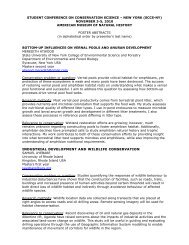SRMP Dynamic Earth Curriculum - American Museum of Natural ...
SRMP Dynamic Earth Curriculum - American Museum of Natural ...
SRMP Dynamic Earth Curriculum - American Museum of Natural ...
You also want an ePaper? Increase the reach of your titles
YUMPU automatically turns print PDFs into web optimized ePapers that Google loves.
Science Research Mentoring Program<strong>Dynamic</strong> <strong>Earth</strong>Session Nine: Other Bodies & TectonicsACTIVITY: Magic PlanetUse Magic Planet to view <strong>Earth</strong> and other solar system bodies. If Magic Planet is not available, useCelestia to view other bodies, or download skins from www.mapaplanet.org/explorer/help/data_set.htmlStudents gather around Magic Planet so that all can see. Present as follows.<strong>Earth</strong>’s Plate Tectonics – Oceans Draining• Watch as the oceans drain, fill again.• Look for the deepest parts <strong>of</strong> the oceans. What did we call these regions?• When oceans drain the 2nd or 3rd time, pause with the oceans empty.• Look for plate boundaries. What do they look like?• Have each student identify a boundary and what type it is. Have groups identify their region (forRegion Project), and note the boundaries.<strong>Earth</strong>’s Plate Tectonics – Plate boundaries• Were you right? Do other regions look like plate boundaries? Why? What do you think they are?<strong>Earth</strong>’s Plate Tectonics – Oceans draining• Pause program, go to drained oceans again• Identify the type <strong>of</strong> plate boundary. Can you tell which direction the plates are moving?<strong>Earth</strong>’s Plate Tectonics – Plate Movement• Were you right? Groups, note what’s happening in your regions.Optional: Go back to Drained Oceans to see how each type <strong>of</strong> boundary looked.Now let’s look for features on other bodies…View each body in turn. Don’t identify until after students have discussed its features.• What features do you see?• Is there evidence <strong>of</strong> plate tectonics? Of other dynamic processes?• What type <strong>of</strong> rocks would you expect to find here?© 2013 <strong>American</strong> <strong>Museum</strong> <strong>of</strong> <strong>Natural</strong> History. All Rights Reserved. 37
















